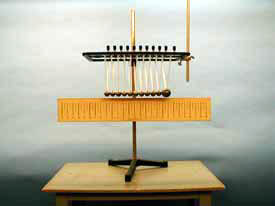Demos: 1N-12 Newton's Cradle

This demonstration is an enlarged version of the classic toy. Several small steel balls are strung in such a way that their centers all lie on a single line. If one ball is pulled back and released, it will knock one ball off the other end at the same speed. This is equivalent to what happens in 1N - 2, except for the intervening balls. No matter how many balls are pulled back, the same number go off the opposite end, at the same speed. Another ball, considerably more massive than the others can brought into play and collisions explored with these unequal masses. It can be shown that if the larger ball is initially at rest and the smaller ball made to collide with it, the larger ball will come to rest every other collision.
Directions: The unit should be adjusted in advance. Look carefully along the line of balls and look for any that appear to be out of line. This is fairly critical for the proper transfer of momentum.
Suggestions for Presentation: Most students have seen this demonstration as a toy, but many are not aware that if there are, say, seven balls and four are pulled back, four will go off the other end. Work it up one at a time. Then ask: If there are more balls pulled back than are left at rest, do the ones at rest have to travel faster after the collision to make up for the lesser mass?
On the large ball, small ball collision, it can be shown algebraically that the results are independent of what the masses are. It’s just that when the masses are equal, the stop occurs every time, in addition to the every other time.
Applications: The classic toy.
Last Updated: Nov 30, 2023 11:25 AM